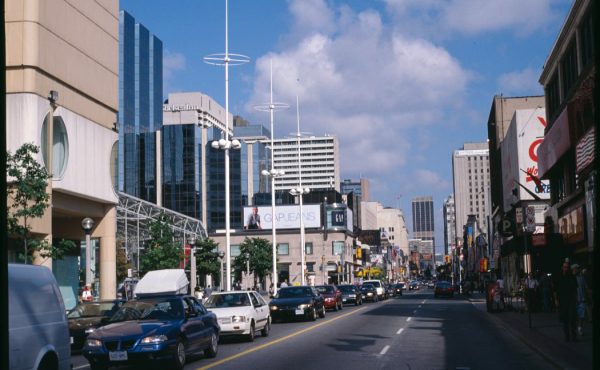
It isn’t what anyone would consider a normal afternoon in the park. Yes, the sun was shining and there were joggers running down the path, as well as picnics set up by the playground. But on the south side of Christie Pits, right next to Bloor Street, was a Refugee Camp in the Heart of the City.
The camp at Christie Pits was set up as a learning tool by Doctors Without Borders, or Médecins Sans Frontières (MSF), to teach us comfortable and often sheltered Canadians the reality of life for refugees. Each tour was led by aid workers who had been on trips with MSF. Our tour guide, Dr. Wendy Lai, had been to the Democratic Republic of Congo as well as Haiti, once before the earthquake and once after.
The first step is the border crossing. As participants, we were all treated as refugees who are on the run from rebels. We are told we have three minutes to flee our homes from rebels who are headed our way. What does one bring? The reality of the situation is that you hardly have time to think. You grab your family, hopefully some money. Maybe some clothes? Some food? Whatever you can carry on your back.
Those trying to leave the country are forced to bribe the border guard with whatever they have: valuables, money, food.
“Do you want to live?”
We hand over things we brought to the park: Gucci sunglasses and some watches.
Before we have time to contemplate what we’ve lost, we have to dodge incendiary devices strategically placed on the ground. Often they are made to look like toys to entice children to pick them up. “They are terrorizing the nation by targeting the children,” says Wendy.
The harsh realities that refugees face every day are outlined throughout the camp. Those lucky enough to make it to a camp with their limbs, health, and family must then live in dirty, overcrowded camps and survive on the bare minimum. While NGOs like MSF try to make the situation bearable by providing food, water, shelter, sanitary toilets, vaccinations, and medicine, some will still die of malnutrition, malaria, or cholera.
And I experienced all of this in the course of an afternoon in the park.
The installation immediately brought back memories of a refugee camp I had seen during a trip to South Africa last summer. Congolese refugees fled to Cape Town in order to seek solace in the big city and escape corrupt police and violence. While the camp in South Africa was relatively small, approximately 120 people, they were only a few if the 1.4 million refugees from the Congo. They all shared two tents and food was distributed by NGOs once a week, rationed by family and with an equal amount for each person; otherwise they would fight over it.
The military base they were on was surrounded by fences and the military, which many of them feared. Congolese people are the largest population of refugees in Cape Town. They end up moving from refugee camp into shanty towns sprinkled throughout the city, and are often persecuted against for stealing the jobs of South Africans. The replica of a Colombian refugee shack I saw at Christie Pits was reminiscent of the homes of about two thirds of Capetonians.
As someone who has seen this firsthand, my experience in Christie Pits felt like a bad dream; a déjà vu without the intense desperation of people fighting for food, without the heartbreaking stories of violence and the inquiries of where I was from and if I could get them into Canada.
The reality that MSF is trying to make plain is that there are 42 million people worldwide who have been uprooted from their homes and are presently living in refugee camps. Of those, 16 million are refugees; another 26 million are internally displaced peoples. (To put this in perspective, the population of Toronto is 2,503,281; Canada’s is just over 33 million.) The key difference between the two terms is that refugees are protected by UN sanctions because they have crossed a border into another country in search of safety. Internally displaced people are seeking refuge within the borders of their own country, and have rights only based on those put in place by their own government.
The tasks of an aid worker are clearly laid out during the tour, from doctors to nurses to logisticians who are responsible for everything from the water pump, to the squat toilets, to the distribution of food.
The tour guides can all attest first-hand to the dire situations that are ever present in refugee camps, and are open to questions about their personal experiences. The monumental contribution of aid workers, and everyday citizens, is the bridge between a brutal death and life. The major difference between visitors to the camp and real refugees is that there were no rebels chasing us and at the end we can go home, and the Gucci sunglasses and watches were returned.
Refugee Camp in the Heart of the City continues until May 30 in Christie Pits Park, and is free to all. The only requirement is that you give yourself an hour to walk through the whole tour, and have an open mind to the harsh reality that exists in war torn countries across the world. Details at refugeecamp.ca.



